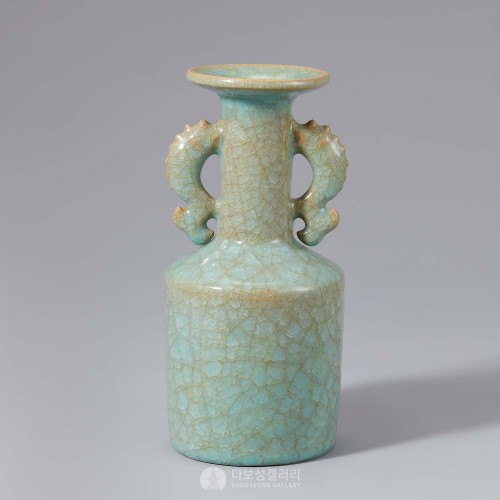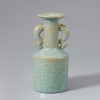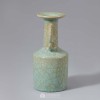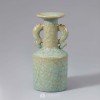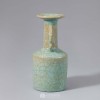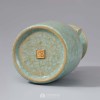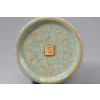본문
나팔처럼 벌어진 구연부에 입 둘레와 목 부분의 꺾이는 곳이 뚜렷하게 구분되어 있으며, 각진 어깨와 일직선으로 떨어지는 원통형 몸통을 가진 북송 여요(汝窯) 청자 반구병이다. 일자로 곧고 길게 뻗은 목에는 물고기 모양의 귀가 양쪽에 붙어 있다. 전체적으로 맑고 부드러운 천청색의 유가 시유되었으며, 표면에는 작은 빙렬이 있고 빙렬 사이사이에 갈색 태토의 색감이 드러나 있다. 굽 바닥에는 '대송여요(大宋汝窯)'라는 관지가 양각되어 있으며 참깨알 같이 작은 지정지마흔(支钉芝麻痕)이 있어, 북송 여요(汝窯)에서 생산된 것임을 알 수 있으며 황제나 귀족의 부장품으로 사용된 귀한 유물로 추정된다.
송대 도자기는 굽에 지정지마흔(支钉芝麻痕)이 있다는 특징이 있다. 이것은 도자기를 구울 때 전면 시유 후 못과 같이 뾰족한 지정(支钉)이라는 받침 위에 도자기를 올리고 구워 생긴 참깨를 닮은 흔적을 말하며, 지마정(芝麻钉) 혹은 지마쟁정(芝麻挣钉) 이라고 부르기도 한다.
This ru-ware vase from the Song Dynasty has a trumpet-form mouth sweeping down to a cylindrical neck angled at the shoulder. The angular shoulder is also mounted on a cylindrical body. The neck is flanked by fish-form handles. The surface is covered overall in pale blue glaze with fine crackles revealing a brown body. The base is engraved in relief with an inscription reading Da Song Ruyao, and elliptical spur marks tell that the present work was produced in the Song Dynasty. It is presumed to be one of the grave goods buried in the imperial or noble tombs. One of the characteristics of Song Dynasty ceramics is elliptical spur marks on the base. After glazing a ceramic, it is fired on its foot on a support with prongs, leaving oval spur marks. It is commonly known as "sesame marks."
